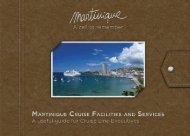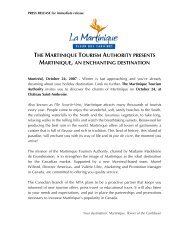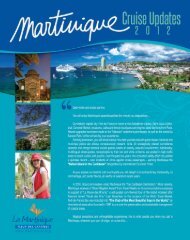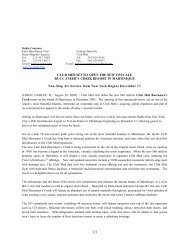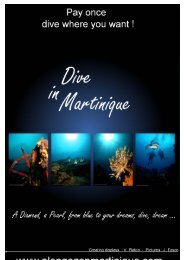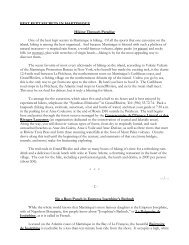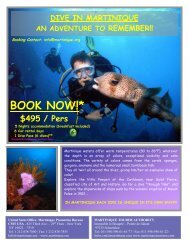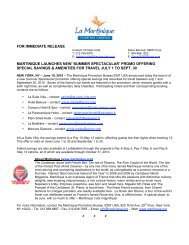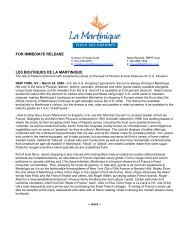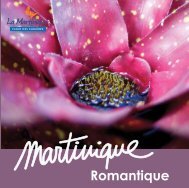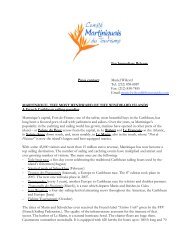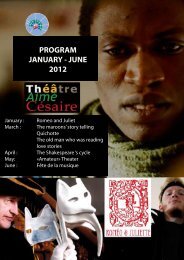sales guide martinique
sales guide martinique
sales guide martinique
Create successful ePaper yourself
Turn your PDF publications into a flip-book with our unique Google optimized e-Paper software.
mid-December to June. There are schools and sailing<br />
clubs that offer instruction in kitesurfing. Martinique<br />
also offers adventure « hikes » across treetops.<br />
13/ What is a yole ?<br />
This traditional Martinican boat is made of wood, and<br />
generally measures from 23 to 35 feet in length. In<br />
the past, yoles were used as fishing boats. The yole<br />
ronde is a boat with a shallow draft, and without a<br />
keel, ballast, center-board, or rudder. It can carry one<br />
or two sails. When on water, the yole ronde is balanced<br />
through the use of wooden poles that transverse the<br />
craft, sticking out well beyond its side. Crew members<br />
climb out on those poles, riding above the waves. It<br />
is quite a sight. The most important race remains the<br />
Tour de la Martinique des Yoles Rondes, organized<br />
16/ Are there any dangerous animals ?<br />
There isn’t much to fear when it comes to animals.<br />
Because of the tropical climate, you’ll probably come<br />
across some harmless insects and small lizards from<br />
time to time. For instance, there are lizards called anolis<br />
that you’ll see on walls everywhere. You may see a<br />
trap-door spider called matoutou falaise while hiking in<br />
the forest, but they are not deadly. There are snakes in<br />
Martinique, but they live far away from human activity,<br />
and encounters with them are extremely rare.<br />
17/ Can you visit working distilleries ?<br />
Yes, because Martinique produces one of the best<br />
agricultural rums in the world. Since 1996, Martinican<br />
rum’s already high quality has been further guaranteed<br />
by its designation as an ‘’Appelation d’Origine<br />
Controlee» (AOC). The island counts some ten working<br />
distilleries, most of them open to the public. A visit to<br />
these distilleries will help you to understand the work<br />
and skill involved in making sugarcane into sugar.<br />
18/ What are fonds-blancs ?<br />
during the school summer vacations.<br />
14/ Are there many kinds of water<br />
activities ?<br />
Windsurfing, water skiing, Optimist (dinghy) sailing, and<br />
big-game fishing are all done in Martinique. But they’re<br />
not the be-all and end-all. The waters of Martinique are<br />
a great terrain for all kinds of sports and adventures,<br />
so it would be a shame if you didn’t try something a<br />
little more original. Keep in mind that safety standards<br />
in Martinique are as high as they are in France. Some<br />
examples of activities :<br />
- Scuba diving (with air tanks)<br />
- Snorkeling<br />
- Circumnavigating the island<br />
- Renting a sailboat with or without a skipper.<br />
- Riding a Jet Ski<br />
Fonds blancs are areas of coastal waters where the<br />
sediments of sand have accumulated to the point<br />
where they almost emerge above the sea’s surface. As<br />
a result, the water inside the barrier is very shallow,<br />
and so a pleasure to splash about in. The most famous<br />
is the « baignoire de Joséphine » (the bathtub of<br />
Joséphine), located in Le François. Legend has it that<br />
Martinican-born Joséphine de Beauharnais, future<br />
wife of Napoléon, liked to bathe there.<br />
19/ Is Carnival a good time to go to<br />
Martinique ?<br />
Keep in mind that all activity on the island will be<br />
geared towards the four days of Carnival, which are<br />
all holidays. The preparations begin on the Sunday of<br />
the Epiphany, with the election of the queens of the<br />
carnival, and they continue until the eve of the first<br />
Carnival day: Fat Sunday.<br />
15/ Are there any beautiful colonial<br />
houses ?<br />
The most beautiful examples of colonial architecture<br />
are to be found on the old sugar plantations, in the<br />
island’s interior. These « habitations, » as they are<br />
called, were built from the 18th century onwards by rich<br />
plantation owners, so they’re tied to the most somber<br />
period in Martinique’s history: that of slavery. Those<br />
habitations that are open to the public will give you an<br />
idea of what life was like in that era, especially if they<br />
still have their original furniture and decor, as is the<br />
case with the Habitation Clément, Habitation Céron,<br />
Habitation Latouche, Habitation Leyritz and Habitation<br />
Lagrange.<br />
82



